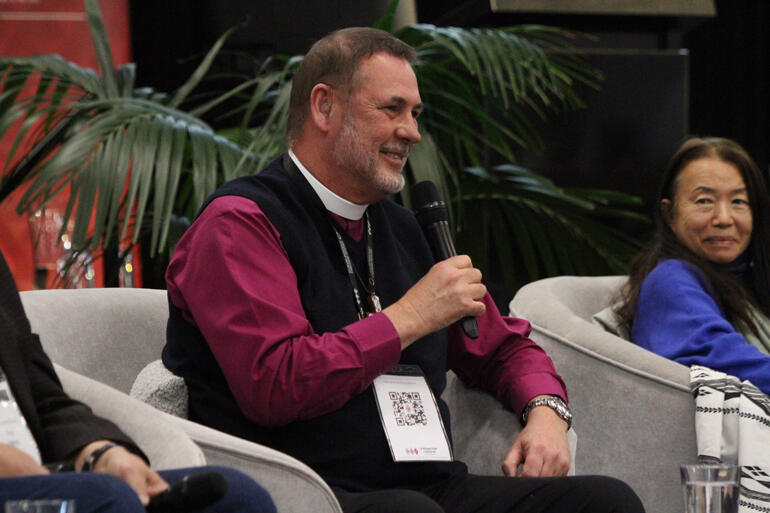Leaders of Te Pīhopatanga o Aotearoa took a close-up look at Mihinare-led education in an afternoon on ministry formation, kura and mātauranga at Te Rūnanganui 2023.
Te Rūnanganui launched into a session focused on Mihinare-led education on Friday afternoon 29 September, uplifted in waiata and prayer by Rev Keri-Ann Hokianga.
Dr Hirini Kaa introduced three panels on education for the day, starting with Archdeacon Susan Wallace, who chairs Te Kotahitanga (the Anglican Church’s policy oversight group for theological education) and Dr Emily Colgan, Manukura of St John the Evangelist Theological College in Auckland.
“We are in rough waters,” Dr Kaa told the room. “We have been for some time now. So we need to consider not the small details, but the big picture, and how mātauranga Māori informs us and shapes us – how we understand, explain and share the Gospel.”
The panel discussed kaitiakitanga, the obligation and rights of tangata whenua to protect mātauranga (knowledge of and held within te ao Māori), as well as who has the right to access it.
Susan shared an update on Te Pae Tawhiti 2040, the Te Kotahitanga and St John’s College Trust Board-backed theological educational research project, which is now in its final reporting stages. Susan proposed its research findings could act as one guide for Gospel-centred, mātauranga-led theological education going forward.
“The whakaaro behind this is to lean into what we as indigenous people have been doing for a long time, and that’s about thinking generationally, rather than in annual lots, in three-yearly lots….
“….and also, how do we test ourselves to be innovative in the future of our education?”
Dr Emily Colgan shared her hopes of seeing mātauranga Mihinare embedded at the centre of College life at Hoani Tapu St John’s: in theological education, in formation, in worshipping life and common life as a community.
The panel went on to discuss everything from how students’ learning could be assessed (say, via essays and exams, versus other forms of identifying mātauranga) to what the advent of Artificial Intelligence might mean for the future of Māori theological education.
Dr Kaa asked Te Rūnanganui members to suggest areas where growth in ministry skills would strengthen the life of the Church. Responses from across the Hui Amorangi included calls to support minita with skills for communications in ministry, connecting rangatahi with the treasures of the Church, and resourcing more people to offer pastoral ministry.
The idea of an Aotearoa-wide accredited mātaraunga-based diploma that would reflect iwi and amorangi diversity also found broad support.
Widening the net on the subject of indigenous theological education, a second panel welcomed overseas indigenous leaders Archbishop Chris Harper (National Indigenous Archbishop of Canada), Bishop Chris McLeod (National Indigenous Bishop of Australia), Kahu Rev Haaheo Guanson (Dean of Waiolaihui’ia Center for Ministry Hawaii) and Rev Dr Ray Aldred (Director of Indigenous Studies Program, Vancouver School of Theology).
The visitors shared their perspectives on indigenous education, noting many challenges facing Aotearoa are similar to those abroad including issues of multi-generational trauma, boarding school survival and redress.
Other similarities included the challenge of leading in churches where the majority of indigenous clergy are unpaid. Archbishop Harper explained that in Canada 90% or more of indigenous clergy are non-stipendiary, so have to work in non-church jobs to bring in an income.
And in Hawaii, indigenous ministry is tightly regulated.
“It touches my heart to see so many people here who have been ordained as priests in so many different ways,” observed Kahu Guanson. “In Hawaii, we must follow the US national church canons, and we have an additional one around being culturally competent. But it’s very rigid. So please know that as you sit here, you are making an impact on not just the people here, but on a global scale, of what theological education means.”
Finally, kōrero turned to the special character of the two Anglican indigenous boarding schools – Te Aute College and Hukarere Girls College, both based in Hawke’s Bay.
Amelia Kaui, hostel manager for Hukarere (who is currently interim hostel manager at Te Aute College) gave a moving account of evacuating the school premises as Cyclone Gabrielle slammed into the region.
She described how the school’s special character, its values of aroha, kotahitanga, tautoko and whakapono – so firmly embedded in daily practice – had allowed them to move to safety quickly, displaying enormous support for one another in the following days and weeks.
“I’m so proud of the girls for showing such resilience, and overcoming losing their kura. We didn’t know the huge importance of our values, until we lost our school.”
“We can say a school value is aroha, but if we don’t lead with aroha, and nurture with aroha, what are we?”
Simon Heath (Te Aute Trust Board) and Wiremu Paenga (Te Aute Chaplain) completed the panel, each sharing how special character manifests within the two schools.
“With Oranga Ake we can deliver the very best education to our students through an indigenous lens,” Simon told the room.
“And the future is very exciting, because as you have witnessed this week, some of the best talent in Aotearoa comes from these two kura. But for too long, these kura have not had the resource, the support and the governance to flourish. Our New Zealand education system has not been good for our Māori students or our Pasifika brothers and sisters.”
Finally, he issued a wero.
“Now is the time to take control and be the architects of our own future.”
“We need to drive our own ecosystem with our own Māori worldview, strong Mihinare principles, so that our unique special character becomes our superpower.”
